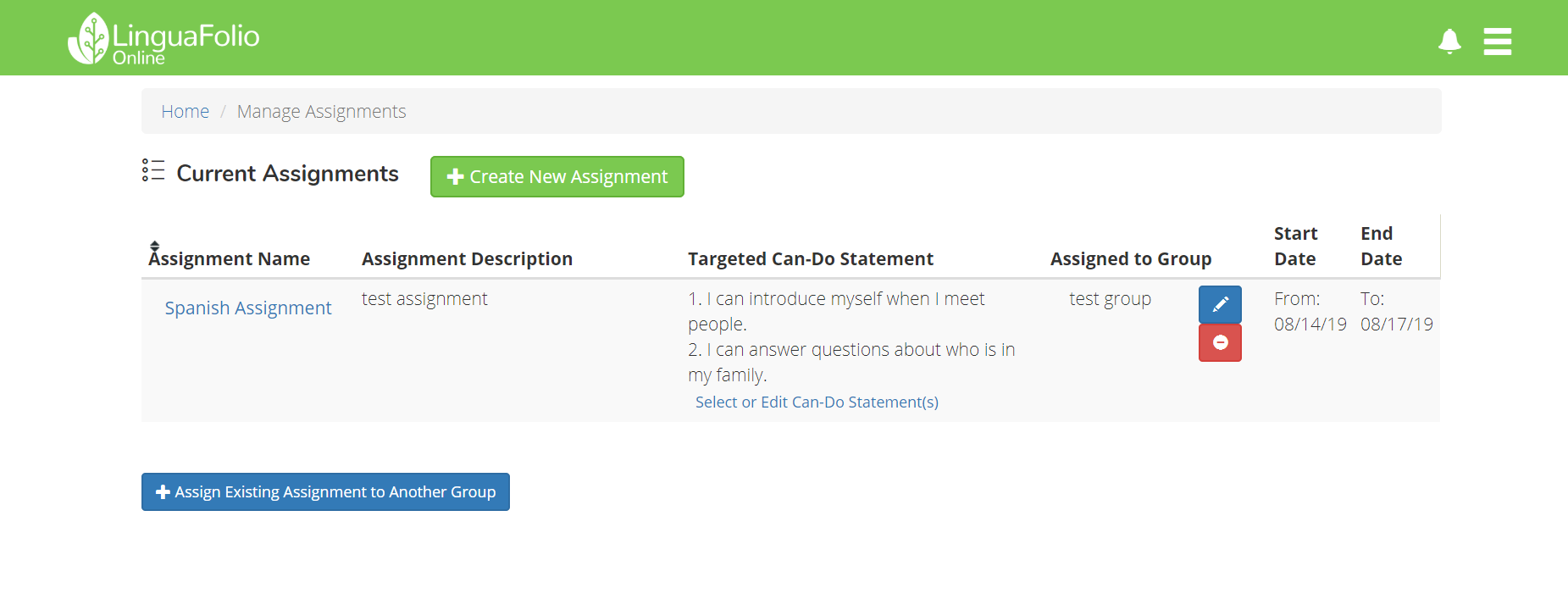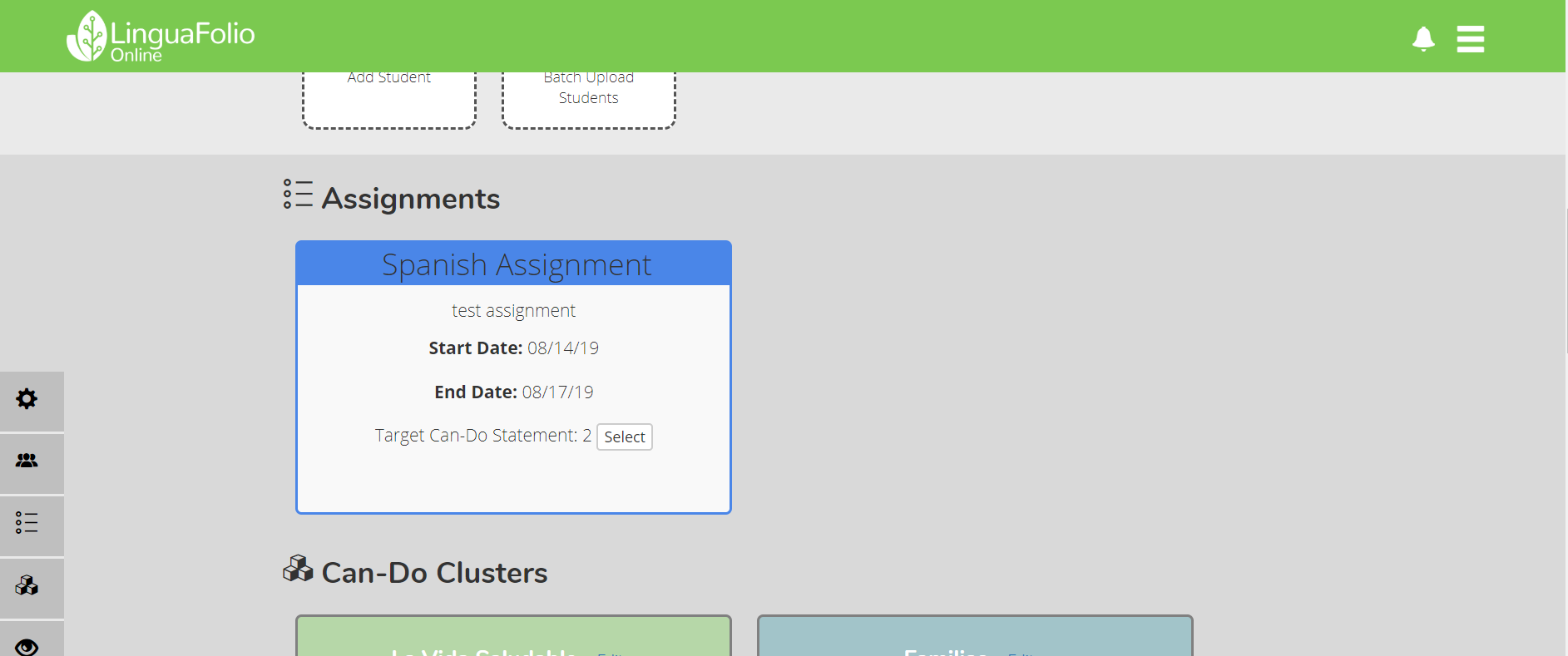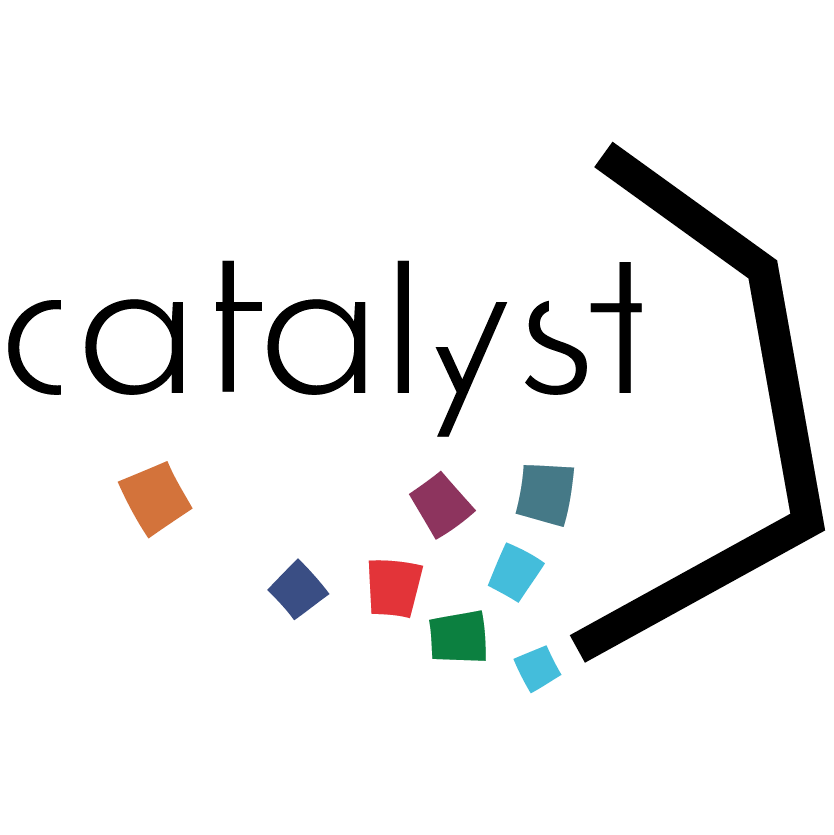Contents
Content Type: 5
Title: Introducing a New Feature for Classic LinguaFolio Online
Body:
Thanks to a partnership with Utah Spanish Dual Language Immersion and ongoing funding from the U.S. Department of Education under grant #P229A180005, we are able to offer an assignment feature to LinguaFolio Online users. Now, instructors can provide assignment descriptions linked to specific Can-Do Statements and specify related due dates.
Here’s an example of what that might look like:
The assignments also conveniently appear on the instructor dashboard so that they can be updated as needed.

With this new feature, teachers have the ability to provide more structure to learners. Try it out for yourself today and email us at lfolio@uoregon.edu if you have any problems.
Source: CASLS
Inputdate: 2019-09-01 08:58:28
Lastmodifieddate: 2019-09-09 04:26:47
Expdate:
Publishdate: 2019-09-09 02:15:01
Displaydate: 2019-09-09 00:00:00
Active: 1
Emailed: 1
Isarchived: 0
Content Type: 4
Title: Resources for Interlanguage Pragmatics
Body:
There are a number of resources available for the teaching and learning of pragmatics (See Sykes, 2016). A few are summarized as this week's Activitiy of the Week to give many examples for those interested in implementing lessons in their classroom.
Dancing with Words: Strategies for Learning Pragmatics in Spanish: A function based website for the teaching and learning of Spanish pragmatics. There are 10 research-based modules with built-in activities designed for classroom use.
American English: Teaching Pragmatics: A website with classroom materials focused on English pragmatics. The site includes downloadable lessons, lesson plans, and multimedia resources.
Strategies for Learning Japanese Pragamtics: A function based website for the teaching and learning of seven speech acts in Japanese. There are seven modules, each focused on a different speech act.
Multimedia interactive modules for education and assessment (MIMEA): A set of multimedia clips with associated activities in Arabic.
BrazilPod: A set of multimedia clips with associated activities in Portuguese.
Sykes, J. (2016). Technologies for Teaching and Learning Intercultural Competence and Interlanguage Pragmatics. In Handbook of Technology and Second Language Teaching and Learning. S. Sauro & C. Chapelle (Eds.), pp. 119-133. New York: Wiley.
Source: CASLS
Inputdate: 2019-09-08 16:53:45
Lastmodifieddate: 2019-09-09 04:26:47
Expdate:
Publishdate: 2019-09-09 02:15:01
Displaydate: 2019-09-09 00:00:00
Active: 1
Emailed: 1
Isarchived: 0
Content Type: 3
Title: Crafting Context: Building Learners’ Pragmatic Competence via Complex Learning Scenarios
Body:
Stephanie Knight, CASLS Assistant Director
Developing the pragmatic competence of learners involves unpacking and exploring the various complexities of communication. One way to approach this process is the use of complex learning scenarios.
Complex learning scenarios, or immersive, play-oriented experiences in which participants work together to complete multistep tasks (e.g., decoding of texts, solving of problems) to discover and unpack critical information about various speech acts, hold incredible potential for the language classroom. These tasks, particularly when woven together by a salient narrative, have the potential to promote meaningful social interaction, high-order cognitive engagement, risk-taking, and the acquisition of critical knowledge and skillsets needed to master the speech act at hand.
In order to articulate a learning environment in which in which these positive affordances are likely realized, teachers should consider three major areas of design: 1) Context/Narrative; 2) Critical Skills/Dispositions; and 3) Content/Concept. Each of these areas is mutually reinforcing. As a result, all three areas should be developed in concert with one another in lieu of in a linear fashion.
- Context/Narrative: The importance of context in language acquisition is widely acknowledged (e.g., Atkinson, 2002; Canale and Swain, 1980; and Hyland, 2007). Establishing a clear context and purpose behind the series of tasks that learners engage in will provide them with the information that they need to truly unpack the speech act around which the complex learning scenario revolves. For example, articulating the social distance, or closeness, one has with fellow interlocutors within the learning scenario will necessarily impact the language choices that should be made.
- Critical Skills/Dispositions: In order to develop pragmatic competence, learners need to develop 1) knowledge of how to form utterances; 2) the ability to analyze language so that they can craft (and interpret) utterances in alignment with their desired illocutionary force (intended meaning); 3) awareness of how utterances impact their fellow interlocutors; and 4) the ability to articulate their reasoning behind the communicative choices that they made (for more information, please see this InterCom post and Sykes, Malone, Forrest, and Sağdıç, in press). In the context of a complex learning scenario, practitioners must consider how the play environment can promote each of those skills; interactions must promote that learners consider all of these facets and should be intentionally designed to foment skill development.
- Content/Concepts: Concepts serve to orient content and promote that learners retain targeted content over an extended period of time. Additionally, they facilitate that learners connect and transfer their content knowledge across domains (Erikson, Lanning, and French, 2017). The spirit of this reality has been explored in L2 contexts in the emerging field of Concept-based Pragmatics Instruction (CBPI). In CBPI classrooms, learners first explore concepts (e.g. social distance) to inform their consideration of how to communicate to achieve desired meaning (e.g. van Compernolle and Henry, 2015). The play environment within a complex learning scenario has the potential to prime learners to orient to this more holistic lens rather than focusing, in a more limited nature, solely on the language content itself (though the content will still be learned).
To better understand how this work might be operationalized, consider, for example, a complex learning scenario designed to help learners understand how to formulate requests (speech act) directed at someone with whom the level of social distance (concept) is high. At the beginning of gameplay, learners are introduced to the narrative (context) of the person to whom they need to learn to make a request and are given information so that they understand why the request must be made in the first place. Then, through a series of interactions designed to cultivate critical skills and dispositions within learners, the learners uncover critical grammar and vocabulary as well as strategies for mitigating requests and for forming both speaker- and hearer-oriented requests (content). To ultimately succeed, learners must formulate requests In a way that demonstrates awareness of the context as well as awareness of their fellow interlocutor’s reactions to their requests.
No matter how the work is operationalized (as a complex learning scenario or in some other iteration), educators delivering lessons related to the study of pragmatics should consider the areas of Context/Narrative, Critical Skills/Dispositions, and Content/Concepts. As such, this week’s Activity of the Week is designed to walk educators through the process of planning while keeping those interrelated areas in mind.
References
Atkinson, D. (2002). Towards a sociocognitive approach to second language acquisition. The Modern Language Journal, 86(4), 525-545.
Canale, M., & Swain, M. (1980). Theoretical bases of communicative approaches to second language teaching and testing. Applied Linguistics, 1, 1-47.
Erikson, H. L., Lanning, L., & French, R. (2017). Concept-based Curriculum and Instruction for the Thinking Classroom. Corwin Publishing.
Hyland, K. (2007). Genre pedagogy: Language, literacy, and L2 writing instruction. Journal of Second Language Writing, 16, 148-164.
Sykes, J., Malone, M., Forrest, L., & Sağdıç, A. (in press). Comprehensive framework for assessing intercultural-pragmatic competence: Knowledge, analysis, subjectivity, and awareness. Encyclopedia of Educational Innovation.
van Compernolle, R. A., & Henery, A. (2015). Learning to do concept-based pragmatics instruction: Teacher development and L2 pedagogical content knowledge. Language Teaching Research, 19(3), 351-372.
Source: CASLS
Inputdate: 2019-09-13 09:31:54
Lastmodifieddate: 2019-09-16 04:26:50
Expdate:
Publishdate: 2019-09-16 02:15:01
Displaydate: 2019-09-16 00:00:00
Active: 1
Emailed: 1
Isarchived: 0
Content Type: 4
Title: Crafting Context in Your Classroom
Body:
This activity is designed to help teachers plan a lesson related to the development of pragmatic competence in learners. Note that while the components are presented in a particular order, all three are mutually reinforcing and should be developed in concert.
Outcomes:
Teachers will be able to:
- Articulate the context in which learners will explore a relevant language function
- Articulate the critical skills and dispositions they wish to help learners develop during a given lesson
- Articulate the relevant content and concepts in a learner experience centered on a relevant language function
Materials: Complex Learning Scenario Design Template
Procedure:
1. Begin with a brainstorm about what language functions, content/concepts, or critical skills you want your students to develop and acquire. For example, for the language function of apologies, you may want learners to explore how social distance (how well speakers know one another) impacts their language choices and teach them to notice social cues that indicate if an apology is accepted or not.
2. Then, fill out the Complex Learning Scenario Design Template. For each box, address the questions and fill in any additional relevant information that will help you craft your learning scenario. As you fill them in, make sure that all of the boxes, when taken together, form a cohesive lesson. You may wish to work on all the boxes at once or do one box at a time and revisit them in concert at the end. They key here is that you are in the driver’s seat! Work in whatever way supports your cognitive processes. An example of how each box might be addressed for a lesson about apologies is provided below:
- Context/Narrative: What is the given context? What will happen? What needs to be resolved? A student asks to borrow their teacher’s book and accidentally spills coffee on it. Now, the student needs to apologize to the teacher in such a way that 1) the apology is understood and 2) the student appears to have been forgiven.
- Critical Skills/Dispositions: What cognitive and social skills do you want your learners to develop and refine? How will the play environment facilitate said development? During the scenario, the teacher will indicate, with various non-verbal cues, the degree to which the apologies is accepted and whether the student is forgiven. The student must demonstrate awareness of these cues and draw conclusions that discern whether the teacher’s degree of acceptance is more related to intercultural norms than it is to personality.
- Content/Concepts: What content/concepts will be involved? Learners will demonstrate understanding of common semantic chunks related to apologies we well as an understanding of strategies (e.g., grounders/explanations) to use to support the delivery of an apology in a situation in which the social distance is considerably high and there is a power differential (the person who is receiving the apology holds more power in the relationship).
Notes:
Though this activity uses apologies as its example language function, any language function could be substituted.
Source: CASLS
Inputdate: 2019-09-13 09:48:36
Lastmodifieddate: 2019-09-16 04:26:50
Expdate:
Publishdate: 2019-09-16 02:15:01
Displaydate: 2019-09-16 00:00:00
Active: 1
Emailed: 1
Isarchived: 0
Content Type: 5
Title: Congratulations, STARTALK Summer 2019 Programs
Body:
Now that STARTALK summer programs have closed, the Center for Applied Second Language Studies (CASLS) at the University of Oregon extends its congratulations to everyone who participated. This summer, students continued to develop their reflective practices via the use of Pulsar (https://pulsar.uoregon.edu/), an online language learning portfolio developed by CASLS that is based on the LinguaFolio framework. Additionally, STARTALK teacher programs began using Catalyst (https://catalyst.uoregon.edu/) this summer. Catalyst provides a space for teachers to develop professional connections and build a professional dossier based on the TELL framework (http://www.tellproject.org/framework/). CASLS would like to thank our collaborators at PEARLL (http://pearll.nflc.umd.edu/) and NFLC (https://www.nflc.org/) for their ongoing collaboration in these endeavors. CASLS would also like to thank everyone who has used and provided feedback on the new platform. You made this summer truly stellar!

Source: CASLS
Inputdate: 2019-09-13 09:53:37
Lastmodifieddate: 2019-09-16 04:26:50
Expdate:
Publishdate: 2019-09-16 02:15:01
Displaydate: 2019-09-16 00:00:00
Active: 1
Emailed: 1
Isarchived: 0
Content Type: 1
Title: New Issue of Intercultural Pragmatics Journal
Body:
http://www.degruyter.com/mouton
Rosa, María Victoria Martín de la / Romero, Elena Domínguez
Briechle, Lucia / Eppler, Eva Duran
Apresjan, Valentina
Yasrebi, Sepideh
Source: LINGUIST List
Inputdate: 2019-09-14 13:30:55
Lastmodifieddate: 2019-09-16 04:26:50
Expdate:
Publishdate: 2019-09-16 02:15:01
Displaydate: 2019-09-16 00:00:00
Active: 1
Emailed: 1
Isarchived: 0
Content Type: 1
Title: New Issue of Journal of Language Contact
Body:
http://www.brill.com
By: Matthias Urban
Pages: 271–304
By: Maria S. Morozova
Pages: 305–343
By: Agnieszka Brylak
Pages: 344–377
Loss of Morphology in Alorese (Austronesian): Simplification in Adult Language Contact
By: Francesca R. Moro
Pages: 378–403
By: Isabel Deibel
Pages: 404–439
By: Rob Pensalfini and Felicity Meakins
Pages: 440–478
By: Afifa Eve Kheir
Pages: 479–512
By: Gilles Siouffi
Pages: 513–516
By: Miriam Weidl
Pages: 517–522
By: Eliane Lorenz
Pages: 523–531
Source: LINGUIST List
Inputdate: 2019-09-14 13:33:02
Lastmodifieddate: 2019-09-16 04:26:50
Expdate:
Publishdate: 2019-09-16 02:15:01
Displaydate: 2019-09-16 00:00:00
Active: 1
Emailed: 1
Isarchived: 0
Content Type: 1
Title: Book: Voices of a City Market
Body:
By Adrian Blackledge and Angela Creese
Published by Multilingual Matters
Source: Multilingual Matters
Inputdate: 2019-09-14 13:34:50
Lastmodifieddate: 2019-09-16 04:26:50
Expdate:
Publishdate: 2019-09-16 02:15:01
Displaydate: 2019-09-16 00:00:00
Active: 1
Emailed: 1
Isarchived: 0
Content Type: 1
Title: Book: Language Acquisition and the Multilingual Ideal
Body:
By Toshiyuki Nakamura
Published by Bloomsbury
Source: Bloomsbury
Inputdate: 2019-09-14 13:38:03
Lastmodifieddate: 2019-09-16 04:26:50
Expdate:
Publishdate: 2019-09-16 02:15:01
Displaydate: 2019-09-16 00:00:00
Active: 1
Emailed: 1
Isarchived: 0
Content Type: 1
Title: Book: Reflective Practice in ELT
Body:
By Thomas S. C. Farrell
Published by Equinox Publishing
Source: Equinox Publishing
Inputdate: 2019-09-14 13:40:58
Lastmodifieddate: 2019-09-16 04:26:50
Expdate:
Publishdate: 2019-09-16 02:15:01
Displaydate: 2019-09-16 00:00:00
Active: 1
Emailed: 1
Isarchived: 0
